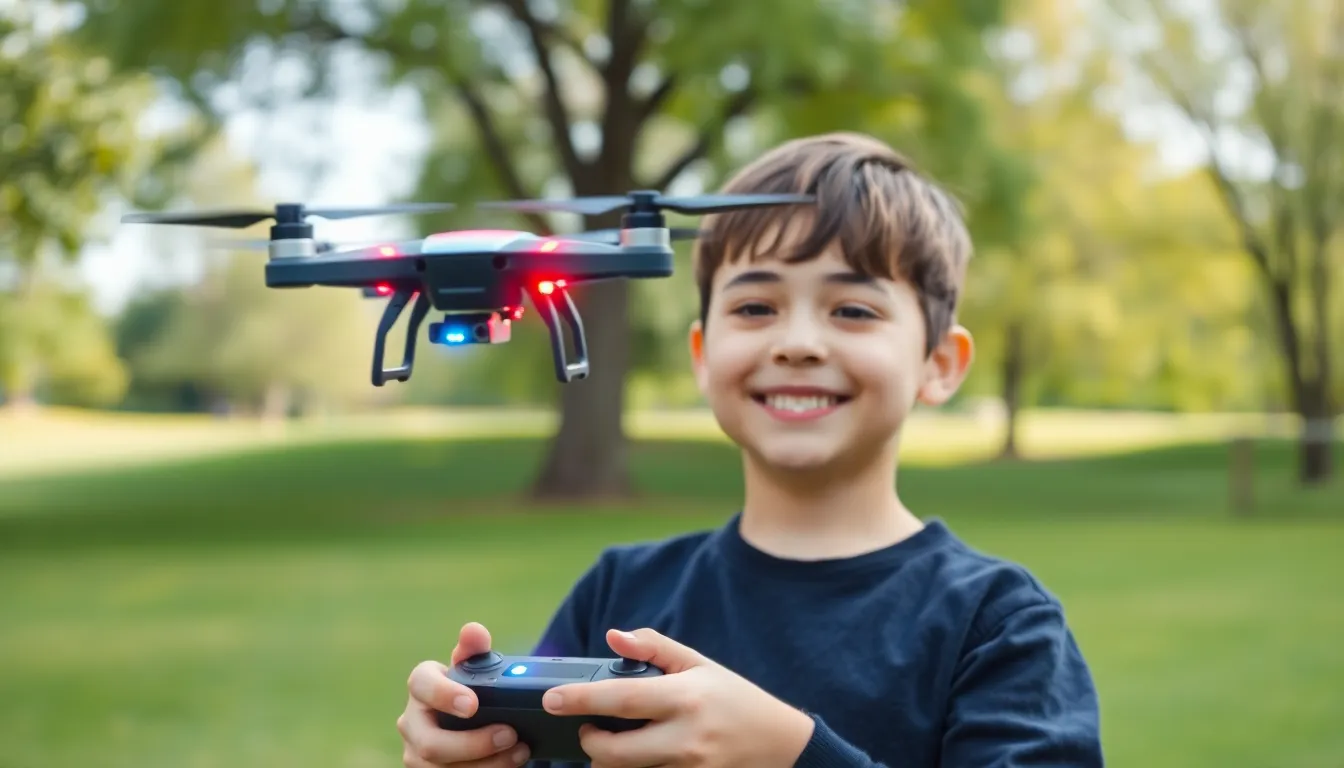Drones for children are soaring in popularity, and it’s no wonder why. Imagine a world where kids can explore the skies without leaving the ground. These flying gadgets not only spark creativity but also teach valuable skills like hand-eye coordination and problem-solving. Plus, who wouldn’t want to impress their friends with aerial acrobatics?
Table of Contents
ToggleOverview of Drones for Children
Drones designed for children combine technology and fun, making them highly appealing to young users. These devices serve as tools for exploration, allowing kids to gain an understanding of aerodynamics and flight principles. Some models emphasize safety features, like propeller guards, ensuring a lower risk of injury during play.
Many drone kits include user-friendly controls, enabling simple operation for beginners. Features like altitude hold assist young pilots in stabilizing their flight, while one-key takeoff and landing simplify the experience. Engaging with drones offers children opportunities to develop vital skills, including focus and patience.
Customizable designs also attract young drone enthusiasts. Adding personal touches through stickers or custom colors fosters creativity and self-expression. Some drones include cameras, encouraging kids to capture aerial photographs or videos, thus blending play with learning.
It’s important for parents to consider age-appropriate drones. Specific models cater to younger children, often featuring robust designs and limited speed settings. Research shows that drones for ages eight and up typically prioritize ease of use, making them ideal for novices.
Educational aspects of flying drones cannot be overlooked. Operating these devices introduces concepts like physics and programming in an engaging manner. Finally, joining local drone clubs can enhance social interaction, allowing children to meet peers who share similar interests.
Benefits of Drones for Children

Drones offer numerous benefits for children, enhancing their play and learning experiences in exciting ways.
Educational Value
Drones serve as engaging tools that introduce children to scientific principles. They help kids understand concepts such as aerodynamics and physics through practical application. Capturing aerial videos or photos fosters a sense of creativity while encouraging exploration. Many drone models include programming features, enabling children to learn basic coding skills as they control their devices. Furthermore, flying drones promotes analytical thinking, providing opportunities to experiment with different flight patterns and techniques. Children gain knowledge not only about technology but also about environmental awareness through observing landscapes from above.
Skill Development
Flying drones demands specific skills that children can develop over time. Hand-eye coordination improves significantly as they learn to pilot their drones effectively. Navigating obstacles enhances spatial awareness, making it easier for kids to understand their surroundings. Problem-solving skills strengthen when kids encounter challenges during flight, pushing them to find solutions quickly. Many drones come with user-friendly controls, allowing children to build confidence as they master their flying techniques. Engaging in aerial acrobatics or racing drones also encourages teamwork and communication when participating in group activities.
Types of Drones Suitable for Kids
Drones designed for children come in various types, each serving unique purposes and benefits. Understanding these options aids parents in making informed choices.
Mini Drones
Mini drones are perfect for beginners. Their small size makes them easy to handle and ideal for indoor flying. Many mini models include user-friendly features like one-key takeoff and landing. Children can practice flying in a safe environment while enjoying quick aerial maneuvers. Most mini drones prioritize safety, incorporating propeller guards to prevent injury. This type of drone allows kids to learn the fundamentals of flying without overwhelming them, fostering confidence as they gain skills.
Camera Drones
Camera drones offer a captivating experience for children. Kids explore photography while flying, capturing stunning aerial shots. Many camera-equipped models have simple controls, making it easy for beginners to take photos and videos. These drones encourage creativity, allowing kids to experiment with angles and perspectives. Safety features, including built-in altitude hold, help kids maintain control during flights. Engaging in aerial photography motivates interest in technology and art, providing a valuable learning experience.
Safety Considerations
Safety is crucial when choosing drones for children. The right model depends on the child’s age, skill level, and the drone’s features.
Age Appropriateness
Selecting age-appropriate drones ensures a safe and enjoyable flying experience. Drones designed for younger children typically feature simplified controls that enhance ease of use. For instance, mini drones cater to kids aged six and up, allowing safe indoor flying. Older children can handle more advanced models, particularly when they demonstrate better coordination and understanding of flight techniques. Assessing the manufacturer’s recommended age guidelines helps parents make informed choices that prioritize safety and suitability.
Safety Features
Incorporating safety features significantly reduces risks associated with flying drones. Many models are equipped with propeller guards that prevent injuries during crashes. Automatic altitude hold and one-key takeoff features simplify operations for novices, promoting confidence in new pilots. GPS functionality in some drones adds another layer of safety by enabling return-to-home features if the drone goes out of range. Encouraging children to fly in open, unobstructed spaces further minimizes hazards, making drone flying a safer activity.
Popular Drone Models for Children
Multiple drone models cater specifically to children, each offering unique features. The Holy Stone HS210 serves as an excellent entry-level drone. It includes propeller guards, making it safe for younger users, and its one-key takeoff enhances ease of use.
Another great option is the Snaptain SP350, which features a 720p camera. This model allows children to capture photos and videos, encouraging creativity and exploration. It also supports altitude hold, making flight control easier.
DBPOWER MJX X401W stands out with its advanced features. This model includes a first-person view (FPV) capability, enabling kids to experience live video while flying. Its headless mode simplifies navigation, appealing to beginners.
The EACHINE E010 is a mini drone that’s perfect for indoor flying. Compact size and lightweight design promote safe operation within the home. Children can practice flying without extensive space requirements.
For older kids, the DJI Tello offers a more sophisticated experience. It combines a robust camera with programming options, introducing children to basic coding skills. This drone also includes safety features like low battery protection.
Safety must be a priority when selecting drones for children. Many of these models incorporate essential features like durable construction and protective guards. Ensuring age-appropriate choices enhances both enjoyment and safety during flight.
Drones for children offer an exciting blend of fun and education. They encourage creativity while teaching valuable skills like hand-eye coordination and problem-solving. With various models available, parents can find the perfect drone that suits their child’s age and skill level. Safety features ensure a secure flying experience, allowing kids to explore the skies confidently.
By engaging in activities like aerial acrobatics or photography, children not only learn about flight but also develop teamwork and communication skills. Joining local drone clubs can further enhance their social interactions, fostering connections with peers who share similar interests. Overall, drones are more than just toys; they’re tools for exploration and learning that can inspire the next generation of innovators.


